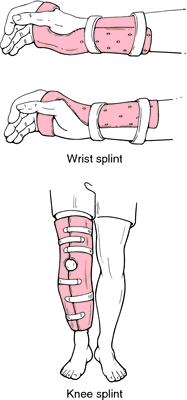Denis Browne splint
Also found in: Dictionary, Thesaurus, Encyclopedia.
splint
[splint]1. a rigid or flexible appliance for fixation of displaced or movable parts; see also orthosis.
2. to supply support for the purpose of immobilizing an injured or displaced body part.

Uses. Splints are most commonly used to immobilize broken bones or dislocated joints. When a broken bone has been properly set, a splint permits complete rest at the site of the fracture and thus allows natural healing to take place with the bone in the proper position. Splints are also necessary to immobilize unset fractures when a patient is moved after an accident; they prevent motion of the fractured bone, which might cause greater damage.
In a pelvic or spinal fracture, the effect of splinting is achieved by placing the patient on a stretcher or board. Breaks of the ribs and of face and skull bones usually do not require the use of splints, since these parts are naturally splinted by adjacent bone and tissue.
In a pelvic or spinal fracture, the effect of splinting is achieved by placing the patient on a stretcher or board. Breaks of the ribs and of face and skull bones usually do not require the use of splints, since these parts are naturally splinted by adjacent bone and tissue.
Making and Applying Splints. A splint can be improvised from a variety of materials, but should usually be light, straight, and rigid. It should be long enough to extend beyond the joint above the injury and below the fracture site. A board used as a splint should be at least as wide as the injured part. Tightly rolled newspapers or magazines can be used to splint the arm or lower leg. Ice cream sticks have been used as splints for broken fingers.
Splints should be padded, at least on one side. Thick soft padding permits the injured part to swell and reduces interference with circulation. Bandages or strips of cloth or adhesive tape are used to hold splints in place. Pulses distal to the injury should be checked before and after splinting to determine whether the blood supply has been impaired. If the limb becomes cold, pale, or blue, or if the affected part becomes too painful, the splint should be loosened. Splints should never be tight.
Splints should be padded, at least on one side. Thick soft padding permits the injured part to swell and reduces interference with circulation. Bandages or strips of cloth or adhesive tape are used to hold splints in place. Pulses distal to the injury should be checked before and after splinting to determine whether the blood supply has been impaired. If the limb becomes cold, pale, or blue, or if the affected part becomes too painful, the splint should be loosened. Splints should never be tight.
Internal Splints. Internal splints, as well as pins, wires, and other devices for the fixation of fractures, are among the more spectacular advances in orthopedics. They have worked wonders in the setting of hip fractures, especially in older people. Internal splints are available for almost every type of fracture. Stainless steel, titanium, and Vitallium are the most commonly used materials. Splints and devices of this type require surgery for insertion, but are less cumbersome than external splints and permit earlier use of the fractured bone.

Types of splints. From Lammon et al., 1996.
airplane splint one that holds the splinted limb suspended in the air.
anchor splint one for fracture of the jaw, with metal loops fitting over the teeth and held together by a rod.
Balkan splint Balkan frame.
coaptation s's small splints adjusted about a fractured limb to produce coaptation of fragments.
Denis Browne splint a splint for the correction of clubfoot, consisting of two metal footplates connected by a crossbar.
dynamic splint a supportive or protective apparatus that aids in initiation and performance of motion by the supported or adjacent parts.
flexion splint tenodesis splint.
functional splint dynamic splint.
shin s's strain of the long flexor muscle of the toes, occurring in athletes and marked by pain along the tibia.
Taylor splint a horizontal pelvic band and long lateral posterior bars; used to apply traction to the lower limb.
tenodesis splint an orthosis that allows pinch and grasp movements through the wrist extensors.
Thomas splint two iron rods joined at the upper end by an oval iron ring or half-ring, and bent at the lower end to form a W shape; used to give support to the lower limb and remove the weight of the body from the knee joint by transferring it to the pelvis.
Miller-Keane Encyclopedia and Dictionary of Medicine, Nursing, and Allied Health, Seventh Edition. © 2003 by Saunders, an imprint of Elsevier, Inc. All rights reserved.
Den·is Browne splint
(den'is brown),a light aluminum splint applied to the lateral aspect of the leg and foot; used for torsional deformities of the leg, ankle, or foot in children.
Farlex Partner Medical Dictionary © Farlex 2012
Den·is Browne splint
(den'is brown splint)A light aluminum splint applied to the lateral aspect of the leg and foot; used for clubfoot.
Medical Dictionary for the Health Professions and Nursing © Farlex 2012
Browne,
Sir Denis John, English surgeon, 1892-1967.Denis Browne bucket
Denis Browne forceps
Denis Browne pouch - a common lodging site for undescended testes. Synonym(s): superficial inguinal pouch
Denis Browne splint - a light aluminum splint used for clubfoot.
Denis Browne talipes hobble splint
Denis Browne tray
Medical Eponyms © Farlex 2012